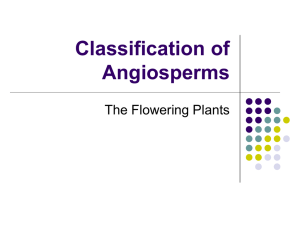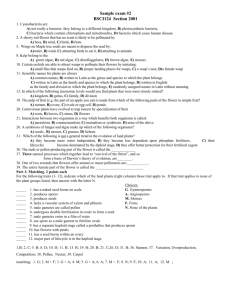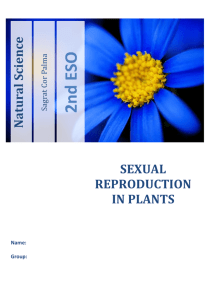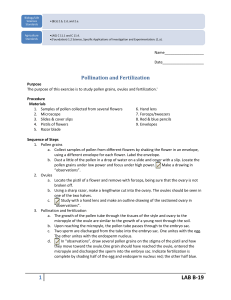Mission 2
advertisement
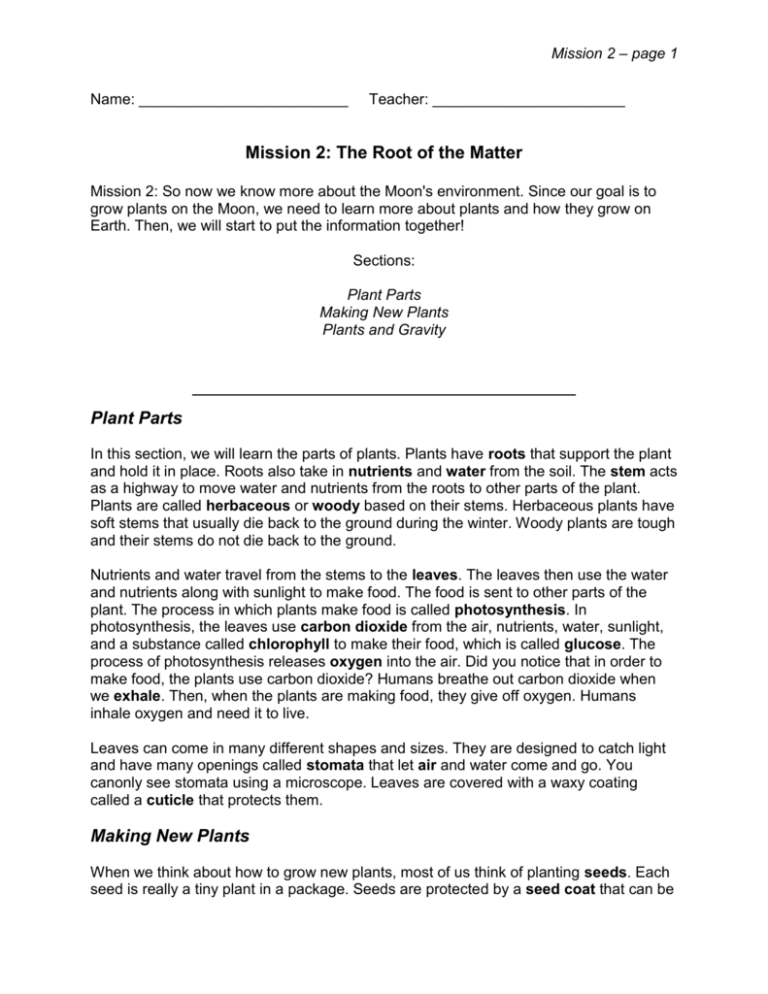
Mission 2 – page 1 Name: _________________________ Teacher: _______________________ Mission 2: The Root of the Matter Mission 2: So now we know more about the Moon's environment. Since our goal is to grow plants on the Moon, we need to learn more about plants and how they grow on Earth. Then, we will start to put the information together! Sections: Plant Parts Making New Plants Plants and Gravity Plant Parts In this section, we will learn the parts of plants. Plants have roots that support the plant and hold it in place. Roots also take in nutrients and water from the soil. The stem acts as a highway to move water and nutrients from the roots to other parts of the plant. Plants are called herbaceous or woody based on their stems. Herbaceous plants have soft stems that usually die back to the ground during the winter. Woody plants are tough and their stems do not die back to the ground. Nutrients and water travel from the stems to the leaves. The leaves then use the water and nutrients along with sunlight to make food. The food is sent to other parts of the plant. The process in which plants make food is called photosynthesis. In photosynthesis, the leaves use carbon dioxide from the air, nutrients, water, sunlight, and a substance called chlorophyll to make their food, which is called glucose. The process of photosynthesis releases oxygen into the air. Did you notice that in order to make food, the plants use carbon dioxide? Humans breathe out carbon dioxide when we exhale. Then, when the plants are making food, they give off oxygen. Humans inhale oxygen and need it to live. Leaves can come in many different shapes and sizes. They are designed to catch light and have many openings called stomata that let air and water come and go. You canonly see stomata using a microscope. Leaves are covered with a waxy coating called a cuticle that protects them. Making New Plants When we think about how to grow new plants, most of us think of planting seeds. Each seed is really a tiny plant in a package. Seeds are protected by a seed coat that can be Mission 2 – page 2 thick or thin. Seeds have all of the materials inside of them that they need to form leaves, stems, and roots. But, seeds stay dormant until the conditions are right for them to begin to grow, usually warm and wet. Germination is when a root and a shoot begin to grow out from the seed. This is the beginning of a new plant! There are many things that can go wrong to cause poor germination. If a plant gets too much water, then it might not have enough oxygen to grow. Also, very dry conditions might mean that the plant cannot get enough water to germinate. If seeds are planted too far in the ground, they might use up all their energy before they can get to the sunlight. Some plants have flowers. Flowers are not only pretty to look at, but they also help the plant make seeds. Flowers can be made up of different parts, but there are some parts that all flowers have. Sepals are the green petal-like parts at the bottom of the flower. Sepals help protect the flower buds. The main flower parts are the male part called the stamen and the female part called the pistil. The stamen is made of anthers and filaments. The anthers carry the pollen and are generally yellow in color. Anthers are held up by the filaments, a thread-like part. The pistil is made of a stigma, a style, and an ovary. The stigma is the sticky surface at the top of the pistil that traps and holds the pollen. The style is tube-like and holds up the stigma. The style leads down to the ovary that holds the ovules. When pollination happens, pollen moves from the male parts to the female parts. Pollen grains land on the stigma. Then, a tiny tube grows from it and down the style into the ovary. The ovule then becomes the seed and the ovary becomes the fruit. Pollen moves from the male to female plant parts with the help of insects, the wind, and animals. Since flowers can't move, they need to get pollinators to come to them some other way. That is one reason why flowers are bright colors and smell good. Flowers may be built so that wind is able to pollinate them or so that pollen can stick to the hair of animals as they pass by the flowers. Bees, butterflies, insects, and birds like the bright petals and sweet nectar of flowers. Some flowers open at special times for pollinators, such as plants that open at night and are pollinated by bats. Some plants do not have flowers. Plants such as ferns, mosses and mushrooms make spores instead of seeds. Ferns make their spores under their leaves. They look like brown spots on the bottom of the leaves. There are still other ways to grow a new plant! A bulb is a tiny packaged-plant that has everything necessary to grow a new plant. Bulbs have carbohydrates to feed the plant and places for the roots to start growing. Everything is wrapped up very neatly in a tunic. The tunic protects the bulb from drying out. Inside the bulb are scale leaves. They are baby leaves that hold stored food for the bulb. Mission 2 – page 3 Other ways to grow new plants are with tubers and cuttings. A tuber is a fat stem that grows underground and is used for food storage for plants. A cutting is a piece of a plant's stem, root, or leaf that is planted and grows roots. Yummy Plants People eat many different plants in our daily diet. But did you know that we eat all parts of the plants? Here are some biographies of your fellow agronauts: AstroNut - Hi! I'm AstroNut, and I am a peanut. The peanut plant is unusual because it flowers above the ground, but fruits below the ground. Peanut seeds (kernels) grow into a green oval-leafed plant about 18 inches tall. The plant develops flowers around the lower portion of the plant. The flowers pollinate themselves and then lose their petals as the fertilized ovary begins to enlarge. The budding ovary or "peg" grows down away from the plant and forms a small stem that extends to the soil. The peanut embryo is in the tip of the peg, and it penetrates the soil. The embryo turns horizontal to the soil surface and begins to mature taking the form of peanut. The peanut plant continues to grow and flower, eventually producing some 40 or more mature pods. From planting to harvesting, the growing cycle takes about four to five months, depending on the type or variety. Broc - What's up? I'm Broc, and you guessed it - I am a broccoli plant! The edible portion of the broccoli plant is made up of the tender stem and the unopened flower buds. Broccoli from fields is harvested in the early morning because it wilts very rapidly in the sun. Field crates or baskets full or broccoli are then taken to a packing shelter where the broccoli is bunched and iced. The broccoli head (which is what I am) should be cut before the flower buds open. If the buds begin to open and the yellow flower petals begin to show, then the head is over-mature and unfit for market. Broccoli heads for market should be about 9 to 10 inches from the base of the stem to the top of the head. Polly - Howdy! My name is Polly, and I am a strawberry. Plants like me have white, sometimes pink (depending on the variety) flowers that turn into luscious strawberries to enjoy fresh, put into desserts, make jam, or freeze and use later. Strawberry plants develop runners, or baby plants that are attached to the parent strawberry plant. Strawberries grow 6-8 inches tall spreading about one foot across with long runners. Strawberries like well-drained and fairly rich soil, so be sure to add compost or other organic matter when preparing the strawberry patch. We need full sun, and frequent, deep soakings, so also be sure to give adequate water during fruit-bearing season. Mission 2 – page 4 Tate - Hello there! My name is Tate, and I am a potato. Potatoes are tubers, which means we are a special kind of stem that grows underneath the soil. Potatoes are an excellent choice for the home garden. We emerge quickly and grow rapidly. Potatoes grow well under most soil and growing conditions and can be stored for long periods without canning, drying, or freezing. Potatoes are not only delicious but also highly nutritious. Tubers are a good source of trace minerals and several vitamins, including vitamin C. To grow potatoes, people order seed tubers and cut them into several pieces. The ideal seed piece is blocky in shape, has as few cut surfaces as possible, weighs between 1 and 2 ounces (slightly larger than a golf ball), and has two or more "eyes" or buds. Plants and Gravity So, do plants grow the same way in space as they do on Earth? Scientists are learning more about how plants grow in space every day. Gravity plays an important part in plant growth. Remember when we learned in Mission 1 about gravity, the force of attraction that keeps our feet firmly planted on the Earth? We know which way is down because of gravity's pull on us. Well, plants also use gravity to know which way is down. The root tips of plants have special starch grains inside called statoliths. These grains are heavy. They fall to the bottom of the root tip cells and act as a signal. They tell the plant which way is down. If you tip a plant on its side, the heavy grains in the root tip would again be pulled down by gravity, and this would tell the plant which way is down. The root would then start growing in that direction. In the same way that roots use gravity signals to grow downward, shoots use these signals to grow upward. These plant movements are called gravitropism. Scientists want to understand the signals inside a plant that help the shoots to know to grow up and the roots to know to grow down. In spaceflight, where the plant does not have gravity to help the roots and shoots to orient, plants usually get confused and grow in a mixed-up way. In a microgravity environment, the starch grains should float around randomly, just like astronauts do. Instead, scientists have found that they bunch together. Why? It's part of the mystery. Maybe one day you will help to solve it! Mission 2 – page 5 Plant Report Look back at the information you have learned in Mission 2 and write a report on the next page to Commander Spud Goodroot answering the following questions: 1. What are the major parts of plants and what do these parts do? 2. What are four parts of plants that you can use to grow new plants? 3. How do plants and humans depend on each other to live? 4. If you had to decide right now three plants to take with you to the Moon, which would you take and why? Congratulations! You have completed Mission 2! Mission 2 – page 6 Plant Report To: Commander Goodroot From: __________________ Date: ___/____/_______ ______________________________________________________________________ ______________________________________________________________________ ______________________________________________________________________ ______________________________________________________________________ ______________________________________________________________________ ______________________________________________________________________ ______________________________________________________________________ ______________________________________________________________________ ______________________________________________________________________ ______________________________________________________________________ ______________________________________________________________________ ______________________________________________________________________ ______________________________________________________________________ ______________________________________________________________________ ______________________________________________________________________ ______________________________________________________________________ ______________________________________________________________________ ______________________________________________________________________ ______________________________________________________________________ ______________________________________________________________________ ______________________________________________________________________ Mission 2 – page 7 Mission 2 Glossary air substance needed by many living things including plants, animals, and humans anther the male part of the flower that produces the pollen bulb a miniature packaged plant that contains everything needed to grow a new plant, made up of special scale leaves and food for the plant carbohydrate an organic compound such as sugar or starch which provides energy for living organisms carbon dioxide a gas from the air that is used by plants for photosynthesis, also known as CO2 cells the basic structural and functioning units of all living things chlorophyll green material in plants that is created in the presence of light and is important for photosynthesis waxy coating that protects the leaf cuticle cutting a part of a plant's leaves, roots, or stem which is planted and grows into a new plant dormant being in a resting state (not currently growing) exhale to breathe out filament fine stalk that holds up the anther flower reproductive part of a plant fruit ripe, mature ovary that contains seeds germination activation of a seed that causes it to start to grow glucose a simple sugar that plants make and use as food gravitropism the response of plants to gravity; roots move towards the pull of gravity and shoots move away from the pull of gravity Mission 2 – page 8 herbaceous leaf describes plants that have stems that are soft. These plants die back to the ground in the winter. green part of a plant that collects light and carbon dioxide for photosynthesis nutrients sources of nourishment for living things that are important for growth and survival orient to become adjusted and position oneself; to align with respect to a point of reference ovary part of the female flower that contains the ovules ovule part of the ovary that becomes a seed oxygen substance released into the air by plants as a result of photosynthesis. Plants take in carbon dioxide and release oxygen while humans take in oxygen and release carbon dioxide. petal specialized structure that protect the parts of a flower and also attract birds and insects to help with pollination photosynthesis process by which a plant produces food using water, carbon dioxide, and sunlight pistil female part of the flower that includes the stigma, style, and ovary pollen yellow powder-like material on the anthers which is necessary for a plant to reproduce pollination movement of pollen from the anther to the stigma root underground part of a plant that collects water and nutrients from the soil; also anchors the plant cells at the very tip of a plant root containing particles that respond to gravity and help direct the root to grow down root tips scale leaves the small leaves inside a bulb that hold stored food for the bulb seed part of a plant that will grow into a new plant if the environmental conditions are right; formed by the maturation of the ovule after fertilization seed coat protective outer covering of a seed Mission 2 – page 9 sepal shoot green leaf-like structures that cover a bud and later open up to reveal the petals of a flower emerges from a seed that has germinated and becomes the part of the plant that grows upward spore seed-like structure that plants like ferns, mosses, and mushrooms use to reproduce instead of a seed stamen male part of the flower that includes the anther and filament statoliths special starch grains in the bottom of root tips which tell the plant which way is down stigma sticky surface on the end of the pistil that traps and holds pollen stem part of the plant which holds up the leaves and flowers and serves as a highway to move water and nutrients through the plant stomata pores in leaves that allow plant to bring in carbon dioxide and release oxygen style part of the female flower that holds up the stigma tuber a fat stem that grows underground and is used for storage for plants tunic the outside portion of a bulb that protects it from drying out water substance formed of hydrogen and oxygen needed by many living things including plants, animals and humans woody describes plants that have stems that are hard and stiff, such as trees




